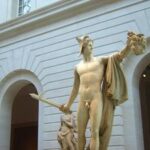Considered by many to be the most outstanding architectural achievement of Golden Age Athens, the Parthenon served as a public meeting place as well as a temple in dedication to Athena. While it is often said to be the most important surviving building of classical Greece, it was not the first of its kind. About thirty years before the current Parthenon was built, the old temple of Athena was destroyed and burned to the ground during the Persian Wars. That being said, you can see how the temple is not just a shrine to the goddess of war, but also thought of as a victory monument. Furthermore, unlike their architectural counterpart in Egypt, who built monuments according to a superhuman scale, the Greeks were infatuated with proportion. Vitruvius, a renowned architect and engineer, observed that any temple was to be modeled after specific ratios of the human body.
The Parthenon represented the climax of a long history of post-and-lintel temple and theatrical buildings among the Greeks. Throughout this history, harmonious proportions along with well planned out structures became the definition of Greek architecture. All of these aspects came together in 448 B.C.E. when Pericles came to commission the infamous project. Along with Pericles were two architects by the names of Ictinus and Kallicrates as well as the sculptor Phidias. It was this team who aided in constructing the temple over a period of more than ten years, from 448 to 432 B.C.E. The plan for the temple was essentially a rectangle building consisting of two separate rooms. Upon first entry, a visitor would be greeted by a walkway that was colonnaded on all four sides. This style of architecture was similar to much of classical Greece due to their love for symmetry. It should also be noted that all of the Parthenon, along with its columns, were constructed strictly through means of the Doric order.
This Doric order originated within the Greek mainland and is often described as being both simple and severe. The other two orders within Greece at the time were the Ionic and Corinthian. However, the Doric set itself apart through many characteristics such as having baseless columns with flutes (concave grooves). Furthermore, after you continue through the hallway, which held the colossal statue of Athena, you would quickly find the second room, the treasury. It was here that the controversial Delian League funds were once stored. While the blueprint of the temple seemed a bit simple, the actual construction of the building was completed using no mortar. Instead, the Greek architects engaged bronze clamps and dowels in order to fasten each individual cut marble segment.
In addition, at the beginning of construction, a “Golden Ratio” was used on the ground plan of the Parthenon. This ideal proportion was numerically set at 8:5 which represents the ideal ratio that is found in nature and in the human anatomy. However, the aspect of the Parthenon that intrigued me the most is the fact that there are virtually no straight lines in the entire building. And while this may at first seem to be done through carelessness, that couldn’t be farther from the truth. After careful analysis and constant scrutiny, it was found that having no flawless features was actually due to their obsession with perfection. For instance, each Doric column swells out near the center in order to counteract the optical illusion of the thinning that occurs with parallel lines. Also, the top step rises over four inches towards the center to insure that the optical illusion of sagging on an extended platform does not occur. Other examples of irregularities are that all of the columns tilt slightly inwards and only the corner ones are thicker. All in all, I became very intrigued by how architects back in 400 B.C.E. were able to point out and correct so many negative optical illusions that regularly occurred.
The Parthenon was seen as a treasured possession to all the Greek people. Its main duty was to house Athena, the goddess of war, the patron of the arts and crafts, and the personification of wisdom. However, above all else, the goddess was chosen as the protector of Athens. The actual location of the shrine was important as well because it was placed on the acropolis summit. This was in such a way that everything could be seen from the Parthenon and it gave a sense that Athena was looking over them. Not only was the temple itself monumental, but some considered the chryselephantine sculpture to be just as heroic. Placed right in the middle of the central hall, this statue was the only known piece that was actually from the hands of Phidias himself.
In addition, you can begin to understand the importance of the Parthenon in that it was the chosen spot for the local treasury. This made it an honorary structure in town that obviously maintained a sense of security. Also, I believe that the building can tell you a lot about the people of that period. For example, only thirty years after being invaded by Persia and having the old temple burned to the ground, the Greeks built a new shrine where the old one once stood. While both may have served the same purpose, being a temple dedicated to Athena, the second structure shows the true colors of Greece. Through perseverance, the Greeks came back from being plundered and arose once again. And that’s why the rebuilt Parthenon holds its name to this day. Not only because it’s a shrine built for Athena, but because it’s a symbol of Greece’s victory through dedication.
Collectively, the Parthenon is often seen as a monumental work of art for many reasons. Through the commissioning under Pericles and with the help of renowned architects, the great shrine was constructed as a technical masterpiece. Additionally, with the use of strict proportions and irregular architecture to counter optical illusions, the Greeks succeeded in creating a temple fit for the goddess Athena. It also became clear as to what the structure meant to the people of Greece due to its location as well as what it symbolizes.





